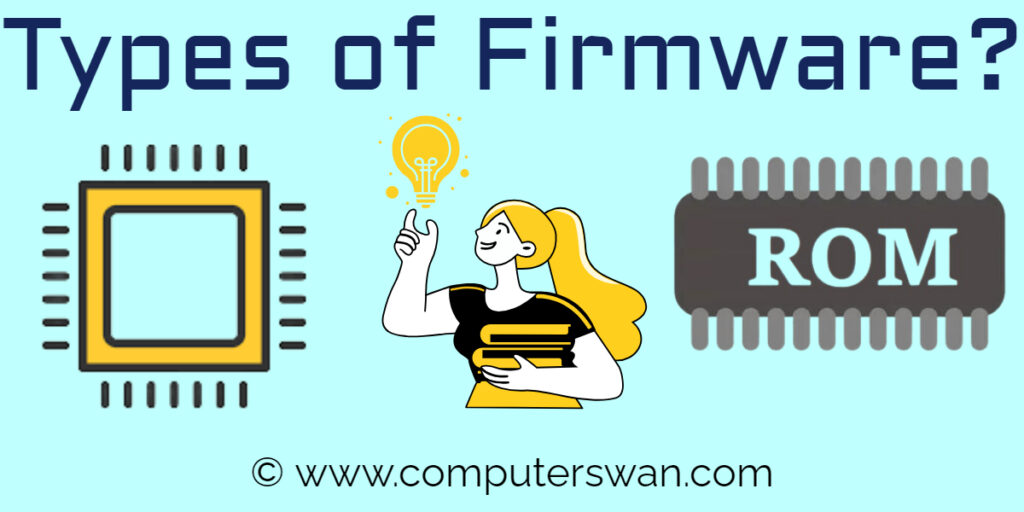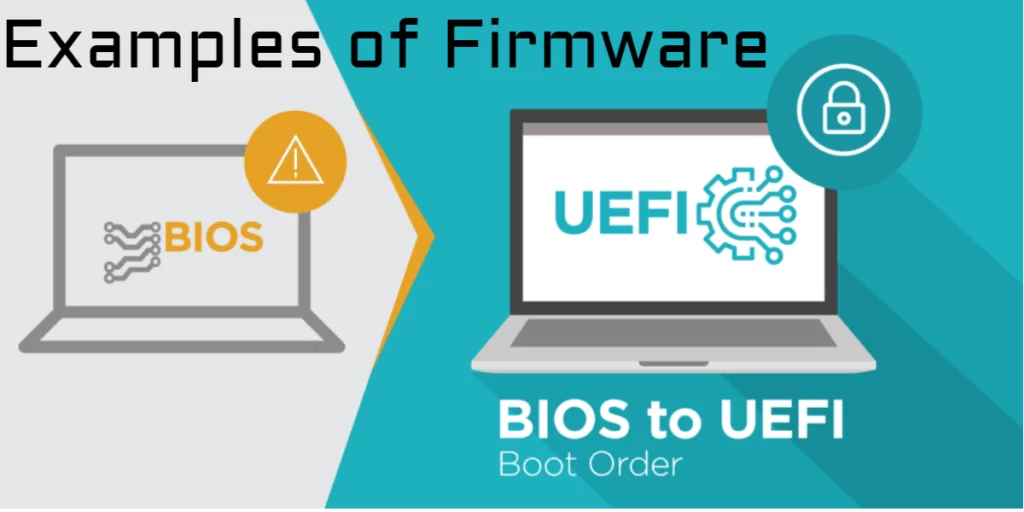Table of Contents
ToggleFirmware Definition :
It is a small software program that is permanently stored in a ‘Read-only Memory’ (ROM) chip. ROM chips are Non-Volatile in nature and do not require a power supply to retain or hold data, unlike RAM memory chips, which need continuous power.
Firmware, often referred to as “software for hardware,” is a type of microcode or program embedded into hardware devices to help them operate effectively and ensuring their efficient operation. Devices like cameras, mobile phones, network cards, optical drives, printers, routers, scanners, and television remotes depend on firmware stored within their memory to operate seamlessly.
Distinct from regular software, firmware’s role is to provide instructions that facilitate hardware initialization, communication with other devices, and the execution of fundamental input/output tasks. n contrast, software, such as web browsers, word processors, media players, and video conferencing tools, is externally installed for interactive user experiences.
Manufacturers regularly issue firmware updates to keep their devices secure and aligned with evolving technology. For instance, Android and iOS devices periodically receive firmware updates aimed at improving performance, introducing new features, and fortifying defenses against security threats. For devices like game consoles and televisions, users usually receive update prompts, which, when accepted, download and install the latest patches, ensuring optimal performance and protection.
Firmware is low-level software for our devices, quietly functioning at a low level, acting as the intermediary between a device’s hardware and its operating system. This critical piece of software is firmly embedded within the memory of hardware devices, working diligently to ensure their smooth operation.
Firmware is a fusion of software and hardware, and it is integrated into the ROM chip during the manufacturing process. Various types of these chips exist, such as read-only memory (ROM), programmable read-only memory (PROM), erasable programmable read-only memory (EPROM), and more.
For instance, small ROM chips are incorporated into devices like TVs, AC remotes, motherboards, hard disks, keyboards, memory cards, digital cameras, and mobile phones. These rom chips come pre-loaded with a small code program or set of instructions. It’s worth noting that BIOS is another form of firmware that already contains instructions.

You can think of firmware as a conductor that organizes the performance of your electronic devices. This is not the typical software that you can install and remove as you wish; Instead, it is permanently embedded in the hardware of various electronic devices. Firmware acts as the vital link between hardware and software, ensuring that they work in perfect harmony.
Firmware is a type of software that resides in a device’s memory. It is responsible for booting the hardware and loading the software necessary for the device to function properly. In simple words, it is the translator that enables your computer, smartphone, or other gadgets to understand the language of their hardware components. This allows devices to perform tasks such as displaying text on your screen, playing music, or connecting to Wi-Fi.
Types of Firmware :
Firmware comes in different flavors to suit the specific needs of different devices. The primary categories of firmware include system firmware, application-specific firmware, and embedded firmware.
System firmware – It is the grand conductor of your computer. This is called BIOS (Basic Input/Output System) or UEFI (Unified Extensible Firmware Interface) that comes into play when you turn on your computer. It handles important tasks such as initializing hardware components and ensuring that the operating system loads correctly. If you want to read in detail about BIOS, then I have written a detailed and amazing article for it, you can open it in the next tab from the following link. (BIOS Article Link)
Application-specific firmware – This type of firmware is like a solo artist, catering to specific devices like gaming consoles, cameras or network routers. It is designed with a specific purpose, ensuring that a device runs smoothly and performs its specified functions.
Embedded firmware – It is the silent worker in everyday devices. You’ll find it in smart TVs, printers, digital cameras, and even refrigerators. This type of firmware manages the core operations of the device, ensuring that everything from screen brightness to Wi-Fi connection works seamlessly.

Firmware provides instructions and guidance that enable a device to:
- Perform basic tasks.
- Function as intended.
- Communicate with other devices.
Firmware is tied to a specific hardware platform. It can bypass a device’s operating systems, application programming interface (APIs), and device drivers.
These diverse firmware types play different roles, but they are all vital to the proper functioning of electronic devices. Firmware is essential because it can improve a device’s: Functionality, Features, Security. Without firmware, your gadgets would be like musicians without a conductor, playing without a tune.
Functions of Firmware :
Now, let’s take a deeper look at what firmware does. The primary functions of firmware include managing hardware components, enabling connectivity, facilitating updates, handling errors, ensuring security, and supporting regular updates.
One of the fundamental roles of firmware is to manage the hardware components within a device. It acts as a translator that helps software communicate with hardware. This means that when you type on your keyboard, the firmware makes sure that your computer understands the key you pressed, and the letter appears on the screen. It also manages hardware such as processor, memory, and storage, optimizing their performance.
Firmware is the major player in enabling connectivity. This ensures that your device can connect to other devices or networks seamlessly. For example, when you connect your smartphone to a Wi-Fi network, the firmware handles the complex process of sending and receiving data packets.
Another important function is to facilitate updates. Firmware is designed to evolve and improve over time. Manufacturers release updates to fix bugs, enhance features, and strengthen security. These updates ensure that your device continues to function at its best.

Firmware is also your device’s protector against errors. It includes mechanisms to deal with errors or unexpected situations, preventing your device from crashing if something goes wrong. This strong error-handling capability keeps your device running smoothly and minimizes interruptions.
Security is a paramount concern in today’s digital world, and firmware plays a vital role. It includes security features to protect your device from threats like viruses and hackers. Manufacturers release security updates to keep your device safe from increasing risks.
Regular updates are a testament to the ever-improving nature of the firmware. These updates enhance features, fix vulnerabilities, and ensure compatibility with new software. It is essential to keep your firmware updated for the best device performance.
In short, firmware ensures that your devices run smoothly and securely. It is the conductor, translator, and protector of your digital computing world.
Examples of Firmware -
As your device or system switches on, it’s the firmware’s job to kickstart the entire startup process. Whether you’re powering up a computer, mobile phone, or tablet, these gadgets rely on different types of firmware to execute essential actions like loading their operating systems.
Firmware operates in a manner somewhat akin to device drivers, but there’s a notable distinction. While drivers find their home within the device’s operating system, firmware is embedded directly into the hardware. Moreover, firmware has the unique ability to initiate the startup process independently, whereas drivers are dependent on the operating system to make things happen. Broadly, there are three levels of firmware:
Low-level firmware: This firmware type typically resides in non-volatile memory chips like read-only memory (ROM) and one-time programmable (OTP) memory. These chips cannot be altered or updated, and the firmware is integral to the hardware, such as a computer.

High-level firmware: In contrast, high-level firmware is stored in flash memory chips and boasts more complex instructions, allowing updates to be applied.
Subsystems: Subsystems refer to semi-independent devices within a more extensive system. Firmware at this level is embedded within central processing units (CPUs), flash chips, and liquid crystal display (LCD) units.
Some common types of firmware include:
BIOS (Basic Input/Output System): An integral part of computers since their early days, BIOS resides on a chip within the motherboard. It provides instructions for loading the operating system and ensures that the device’s hardware components are functioning correctly during startup. BIOS also oversees startup error checks, RAM and processor diagnostics, and connections to peripherals like keyboards and mice.
EFI (Extensible Firmware Interface): Replacing traditional BIOS in newer computers, EFI is responsible for instructing the device’s CPU on hardware startup and bootloader initiation. It offers several advantages, such as ensuring the booting of trusted software and enhancing cybersecurity measures. EFI can also support both Intel and AMD processors, making it more versatile.
Discovering your device’s firmware version is essential for keeping it up to date. In Windows devices, you can determine the firmware version using the command prompt with an upgrade assistant.
For hardware devices, you can find the firmware version by navigating to the Devices Manager, selecting the hardware, and accessing its Properties. Within the Details tab, locate the Property menu, open Hardware IDs, and find the firmware version listed in the Value table. Staying informed about your device’s firmware ensures it runs efficiently and securely.
Software Vs Firmware :
In electronics and computing, you’ll often come across two terms: software and firmware. These terms can sometimes be a bit tricky to distinguish since they both involve data stored within a hardware device. In the world of electronics and computing, you’ll often come across two terms: software and firmware. These terms can sometimes be a bit tricky to distinguish since they both involve data stored within a hardware device.
Software primarily consists of a set of instructions that direct a computer’s hardware to perform specific tasks. It encompasses a wide range of programs, including operating systems, word processors, databases, and various applications. The key characteristic of software is its flexibility – it can be frequently updated, removed, or modified with relatively few consequences, aside from potential data loss. Software files are typically sizeable and can consume significant memory.
On one hand, software consists of a set of instructions that guide a computer’s hardware to perform various tasks. It encompasses operating systems, word processors, executables, databases, and other practical applications. Software is designed to be updated regularly and can often be modified or removed from a system without significant consequences, apart from potential data loss. Compared to firmware, software files are typically large and consume a considerable amount of memory.
Conversely, firmware is a distinct type of software tailored for installation on hardware devices to guarantee their smooth operation. Once integrated, users typically have no direct interaction with firmware. Updates to firmware occur infrequently and are typically delivered by the device’s manufacturer. In specific scenarios, the loss or corruption of firmware can render a physical device non-functional. To mitigate such risks, firmware is usually stored on components that are electrically isolated from the rest of the system, such as EEPROM chips or flash memory. Firmware files tend to be significantly smaller than software files since they lack extensive graphic or user interface data.
Frequently Asked Questions (FAQs) About Firmware :
What is firmware?
Firmware is a type of software embedded into the hardware of electronic devices, typically at a low level. It serves as a bridge between the hardware and the operating system.
What is the primary function of firmware?
Firmware’s primary function is to provide essential instructions and code required for the proper operation of hardware devices. It initializes hardware components during boot-up and ensures effective communication with the operating system.
Are there different types of firmware?
Yes, there are different types of firmware, including BIOS (Basic Input/Output System) firmware, UEFI (Unified Extensible Firmware Interface), and device-specific firmware found in items like routers, printers, and IoT devices.
In which electronic devices are the firmware used?
Firmware is used in various electronic devices, such as smartphones, tablets, printers, routers, game consoles, and smart TVs.
How does firmware impact a device’s functionality?
Firmware directly impacts a device’s functionality by enabling it to communicate with the operating system and other hardware components. It contains specific instructions on how the hardware should perform, essential for smooth operation.
Can firmware be updated?
Yes, firmware can often be updated or upgraded by the device manufacturer to enhance performance, fix bugs, or add new features. Users can check for available updates for their devices.
Is firmware vulnerable to security threats?
Firmware can indeed be vulnerable to security threats, and protecting it is crucial to prevent unauthorized access or modification of device functionality. Security measures are essential to safeguard firmware.
How does firmware work in IoT devices?
Firmware plays a significant role in IoT devices, managing communication between various sensors and the device’s central processing unit. It ensures that data is collected, processed, and transmitted accurately.
Are there risks associated with updating firmware?
Updating firmware carries some risks, as it can sometimes lead to compatibility issues or even device malfunctions if not done correctly. It’s important to follow manufacturer instructions and backup data before updating.
How can users check for firmware updates?
Users can usually check for firmware updates in the device settings or through the manufacturer’s website. Some devices may even notify users when updates are available.
Can outdated firmware cause compatibility issues?
Firmware can affect a device’s compatibility with other hardware or software. Compatibility issues may arise if the firmware is outdated and lacks support for new components or features.
What are the consequences of outdated firmware?
Outdated firmware can lead to security vulnerabilities and operational problems. For example, it might be susceptible to known exploits or may not be compatible with new software.
Is BIOS the same as firmware?
BIOS (Basic Input/Output System) is a specific type of firmware that initializes the hardware during boot-up, ensuring it’s ready for the operating system. Firmware, in general, is a broader term that encompasses various types of embedded software in devices.
Is open-source firmware a good option?
Open-source firmware can be a better option for some devices, especially if users want more control and customization. However, it requires technical expertise to modify and may void warranties.
How does firmware impact smartphones and tablets?
In modern smartphones and tablets, firmware manages device components, like the camera, touchscreen, and sensors, to ensure smooth operation and compatibility with the operating system and apps.
Are there legal implications for modifying firmware?
Modifying or customizing firmware can sometimes have legal implications. It’s essential to review the terms of use and licensing agreements for the specific device and firmware in question.
How often are firmware updates released?
The frequency of firmware updates varies by manufacturer and device type. Some devices receive regular updates, while others may have less frequent releases.
Can firmware improve a device’s energy efficiency?
Firmware can impact a device’s energy efficiency by optimizing hardware usage and ensuring that components go into low-power modes when not in use. This can lead to extended battery life.
How does firmware work in smart home devices?
Firmware is crucial for smart home devices, as it enables communication between sensors, controllers, and central hubs, allowing users to manage and monitor their smart home devices.
Should I update firmware on older devices?
Updating firmware on older devices may lead to performance improvements, bug fixes, and security enhancements. However, there is a risk of compatibility issues with older hardware. Users should weigh the potential benefits against the risks.
